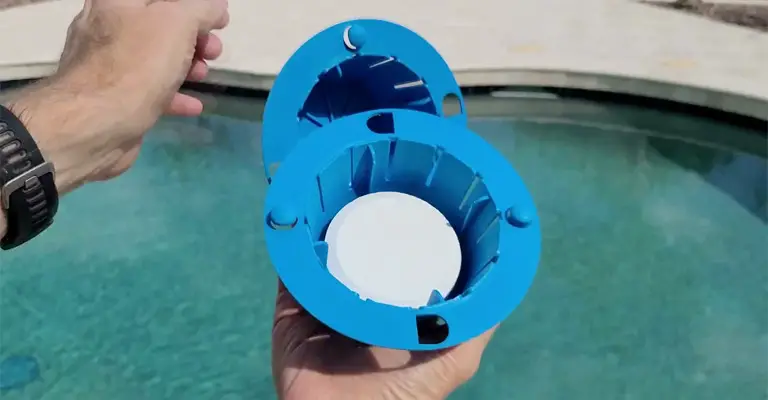The skimmer or pump should never be used to add chlorine tablets. Keeping your pool clean and healthy relies on your pump and filter.
Skimmers dissolve tablets and produce highly acidic water when they are placed in them. As a result of this acidic water, the internal parts of the filter can be compromised.
Therefore, these internal parts will need to be replaced sooner than they need to be. It is also common for people to add too many chlorine tablets when dealing with chlorine.
It is never a good idea to fill your chlorinator or floater to the brim with tablets. In this situation, your pH plummets, leading to acidic water through excessive use of tablets.
Your pool equipment can be ruined, your eyes can burn, and your skin can get itchy.
So, once you realize that you need only one tablet per 10,000 gallons, you will also begin to save money and use less tablets!
What Happens When You Put Chlorine Tablet In The Skimmer?
Placing chlorine tablets in the pool skimmer is a common practice that saves both time and money. It might seem simple and quick to maintain your pool’s sanitation level this way, but you may be harming it more than you know.
Our purpose in this article is to explain how chlorine tablets can negatively affect your pool and its users when placed in the pool skimmer.
Damage To The Skimmer Basket
Chlorine tablets leave behind residue that builds up in the skimmer and causes it to malfunction.
As a result, cloudy water results when the skimmer cannot effectively filter the pool water. As a result of the buildup, the skimmer basket is also difficult to clean, leading to further maintenance problems.
An Unbalanced pH Level
In addition to having a low pH, chlorine tablets can also decrease the pH of your pool overall. When the pH level of the water is too low, swimmers can experience skin irritation and eye irritation.
Additionally, it can cause the surface, machinery, and plumbing of the pool to deteriorate. Chlorine, which kills bacteria in the pool water, can be ineffective if pH levels are unbalanced.
Distribution Of Chlorine Is Uneven
Skimmer water sits stagnant when the pool pump is off until the next pump cycle occurs.
The heavily chlorinated water that remains in the skimmer is not evenly distributed throughout the pool due to the tablets dissolving in the skimmer.
It is possible for swimmers to suffer from respiratory issues, skin irritation, and eye redness when their water is overly chlorinated.
Under-chlorinated pools can become breeding grounds for bacteria and other microorganisms that can cause illness.
Equipment Corrosion And Damage
In concentrated doses, chlorine tablets are highly acidic due to their low pH level. Acidity levels increase with the dissolution of tablets and the buildup of chlorine in the skimmer.
It is acidic water which corrodes the metal components of your equipment as it passes through the pump and filter.
If you have corrosion on your pool equipment, it will cause serious damage over time, requiring expensive repairs and replacements.
The Do’s and Don’ts of Chlorine Tablets
As long as you’re using chlorine tablets properly, they can be very effective at sanitizing your water.
Your chlorine reading in your pool water should never be based solely on chlorine tablets. These tips will help you use chlorine tablets properly, so you can make them work for you.
Dos:
1. Place The Chlorine Tablets In The Chlorinator Or Floater

It is always a good idea to use a chlorinator or floater when using chlorine tablets. You can set the rate at which chorine is dispersed into your pool when you install a chlorinator.
You may be able to adjust the setting when necessary on the unit. The concept of a floater is similar.
You can float it around in the pool and it holds your tablets. You can also adjust how much chlorine is released into your water.
2. Check The Chlorinator Or Floater Weekly And Refill When Necessary

Your weekly maintenance should include adding chlorine tablets to the chlorinator or floater.
If you need to add any tablets to your chlorinator or floater, you should check it every week while adding other maintenance chemicals.
You should refill your chlorinator or floater with tablets if it is empty.
3. For Every 10,000 Gallons Of Water In Your Pool, Add One Three-Inch Tablet

If you want to know your chlorine level, you should not rely on your chlorine tablets. It is only a good idea to use chlorine tablets as a last resort.
For every 10,000 gallons of water in your pool, use one three-inch tablet instead of filling your chlorinator or floater completely.
This amount of tablets will keep your water’s chlorine level high if you are shocking your water weekly.
Don’ts
1. Don’t Rely On Your Chlorine Tablets For Chlorine Readings

If you want to measure chlorine, never rely on chlorine tablets. You will have a much higher chlorine reading as a result of this.
You will also suffer from acidic water in your pool, which causes another set of problems. In order to get a good chlorine reading, you should shock your pool weekly even with tablets.
Final Words
You can cause several health problems to your pool and to the people who use it by putting chlorine tablets directly in the pool skimmer.
The problems above can be avoided in two simple ways! In order to ensure your pool receives the correct amount of chlorine, you can use a floating chlorinator or automatic chemical feeder.








